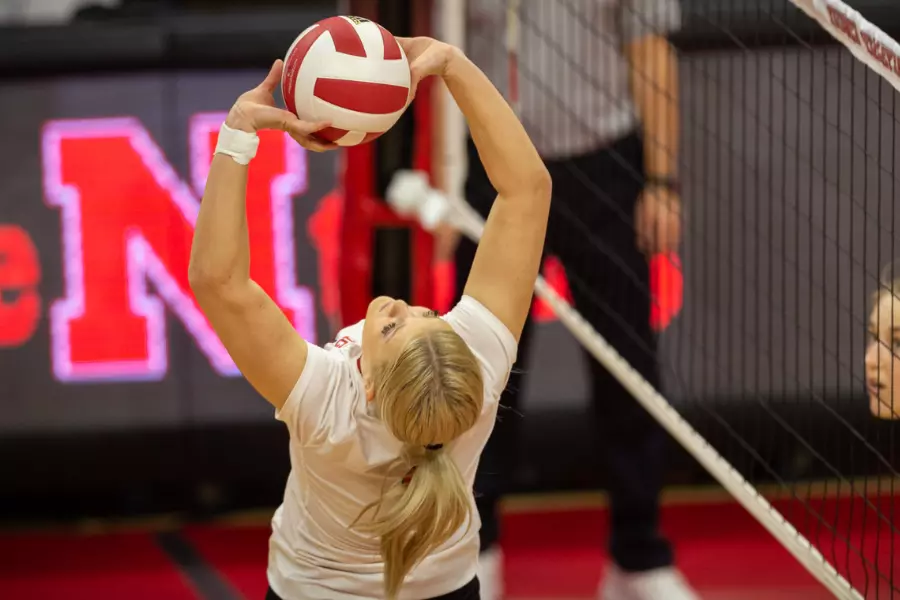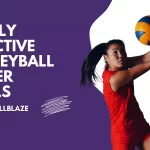Due to their offensive playmaking role, setters aren’t considered tall by most volleyball players. While you may be right, I believe there are several misconceptions about how tall setters should be.
Setters in Olympic men’s volleyball are usually 192cm or 6’3.5′′ tall. The average height of an Olympic women’s setter is 177 cm (5’10”).
In what ways does height matter to setters? How Tall Are Setters In Volleyball?
As well as averages and tips for staying competitive despite your lack of height, here are some averages from different levels of the game.
What Is The Average Height Of A Setter?

In order to answer this question, we must consider the level of play we are referring to.
Numbers may be more interesting than numbers themselves if they are compared with other court positions.
Seeing some of these figures is really surprising!
The average height of a setter compared to other positions
The shortest players on court are typically setters, but most people don’t realize that setters are actually only slightly shorter than outside hitters.
As a spectator during the 2012 Olympics, I was really excited to see some height data based on position.
A setter is only 2 cm shorter than an outside hitter, but 10 cm taller than a libero.
Compared to hitters, setters are actually much shorter than liberos in height.
Olympic Setter Height
In the highest levels of game setting, game setters are getting taller every year.
A male Olympic setter averages 192 cm or 6’3.5″, while a female Olympic setter averages 177 cm or 5’10”.
The 2020 Olympics and the Olympics of 2012 were used as data sources.
Men’s setters on the top four teams from 2012 were on average 195 cm tall. Compared to that, the height at the 2020 Olympics was just 189 cm.
Setters on the four top women’s Olympic volleyball teams were, however, an average of only 173 cm high.
2021 Nations League players averaged 181cm in height.
In other words, women’s setters have seen their height increase massively, while men’s setters have seen their height decrease!
Volleyball setter height appears to be increasing in these data sets, though the number of sets is very small.
You may enjoy reading Best Weighted Volleyballs For Setters
College volleyball setter height
Based on NCSA’s website, here are the average heights of men’s college volleyball setters.
Men’s College Setter Height Ranges
| Division | D1/D2 | D2/D3 | D3/NAIA | NAIA/CCCAA |
| Height | 6’1″ – 6’5″(185.5cm – 196cm) | 6′ – 6’4″(183cm – 193cm) | 6′ – 6’3″(183cm – 190.5cm) | 6′ – 6’5″(183cm – 196cm) |
In the table below, we have the average heights of women who play college volleyball.
Women’s College Setter Average Heights
| Division | D1 | D2 | D3 | NAIA |
| Height | 5’10”(178cm) | 5’8″(173cm) | 5’7″(170cm) | 5’7″(170cm) |
How Tall Is The Average D1 Setter?
Volleyball setters in D1 are typically 5’10” (178 cm) tall. The NCSA website reports that the average height of a D1 volleyball setter is between 6’1″ and 6’5″ (185.5 cm to 196 cm).
Height of a setter is influenced by several factors

Positional Requirements
As well as setter requirements, height is also influenced by them. Short setters have an advantage in agility, quickness, and court vision over taller setters who can reach and block higher sets.
Genetics
In terms of size and shape, setters have a wide range of genetics. Depending on the setter’s genetics, he or she may be naturally taller or taller than others, but they may compensate with superior athletic ability and technique.
Training
Training and development also affect a setter’s height. Strength and conditioning programs don’t take into account an athlete’s natural height.
You may enjoy reading Taller vs. Shorter Setters In Volleyball
How Tall Should A Volleyball Setter Be?

What is the minimum height requirement for a setter?
I can only come up with a yes-and-no answer to this tricky question.
A setter’s height is underrated
If you’re tall, it will make life easier for you as a setter.
A good setter must block well
Setters are often responsible for blocking during rallies. It is common for the setter to face the outside hitter of the other team, who is usually a very talented spiker.
When you are able to block your opponent’s best hitter, you have an advantage over your opponent. You’ll also have a shorter block reach if you’re on the shorter side.
You can be hit completely over your block if your opponent has a lower block reach.
A tall setter has a better chance of competing online
You can also save more passes by jumping setting as a tall setter, besides being a defensive asset.
As a result, every time you joust, you will become more competitive.
You will also have a harder time defending your setter dump.
Team Hitting Efficiency is Improved by Tall Setters
Your front court position forces middle blockers to consider blocking you more often.
As a result, your team’s wing attackers will be able to hit more often since the middle blocker stays in the center of the court for longer.
You may enjoy reading Volleyball Setter Drills
Despite the benefits of height, being short isn’t a deal-breaker
It is often possible to compensate for height deficits in the role of setter by making up for them in other areas.
Your 6cm shorter height isn’t that much of a disadvantage if your block jump is 6cm higher than the average.
As long as you keep your focus on what you can control, you can still be worth having on the court.
- Play with the most consistent and accurate setter that hitters love.
- Become a weapon with your jump serve.
- Develop your volleyball IQ/court awareness.
- Develop your leadership and communication skills.
The Shortest Professional Volleyball Setters

There’s good news if you felt sick to your stomach after reading those numbers. There is hope for those of you who aren’t quite tall enough!
Despite being far too short on paper, some volleyball setters completely defied height benchmarks to succeed as volleyball setters.
Yoshie Takeshita (159cm)
The Japanese national team’s Yoshie Takeshita was a very successful setter, despite only being 159cm tall.
As a retired volleyball player, she still ranks among the world’s top 100 women’s players with over 20 awards.
Matías Sánchez (173cm)
Matas Sánchez is an Argentinean national team player and currently plays for the Paris Saint-Germain side.
His height is 173 cm, which makes him 20 cm shorter than most setters.
Neither is he a great jumper, but he’s excellent at being accurate, consistent, and smart on the field.
Masahiro Sekita (175cm)
Sekita has the same ability to compensate for his undersized size with pure talent as Marashiro Sekita of Japan’s national team.
As a professional footballer in Poland, Sekita proves that height doesn’t count for much.
His spike reach of 311cm is not particularly impressive either, like Sanchez’s.
In addition to being incredibly entertaining to watch, he ought to serve as a source of inspiration for younger, shorter setters worldwide.
How To Succeed As A Short Setter?

Being exceptional at what you can control is the key to success as an undersized setter. I don’t think you’ll be able to block well. However, there is no reason why you can’t become a more precise and smarter playmaker.
If I were a vertically challenged setter, here are a few things I would focus on.
Technique & Accuracy are perfect
To make sure you’re a technically better setter, you’ll have to work harder than other, taller setters. Shorter setters must provide perfect sets to impress with their blocking ability whereas taller setters can show their blocking ability by being a presence at the net.
This isn’t something you can shortcut, unfortunately. Putting in more time and effort is the only way to succeed.
Using a target net, develop accuracy
A volleyball setter target net can help serious setters get enough quality reps in when they are working alone. In the absence of a team to train with, using a net can help you determine your accuracy.
Because they don’t require any volleyball court or net setup, they are great for indoor volleyball. A reliable method of developing accuracy, they can be set up anywhere outside at home.
You should set significantly more often than your competition if they set 300 times a week. Go to training early and stay late if they set 300 times a week.
Setters should focus on improving their weaknesses. Perhaps you don’t set your middle blockers well, so work on them. Try these tough back sets if you have trouble consistently delivering high balls to your right side’s hitting window.
Use a weighted training ball to practice
It may be difficult for you to consistently place the ball where it needs to be because you lack the strength in your wrists and hands. Developing your hand and finger strength may be easier with a weighted training ball.
You’ll notice that setting a regular volleyball becomes easier and smoother when you perform all the same drills with a weighted training ball.
Ensure Your Service Is An Asset
It is important to increase your value as an asset to teams if you are a setter without height. If you are a dangerously reliable server, all may be forgiven if you are a weak blocker.
By practicing and repeating the skill, you will be able to develop it more quickly. Try to serve 50-100 extra serves a week by practicing early and staying late.
As you get more contacts, you’ll eventually become like Yuji Nishida!
Develop your volleyball IQ and communicate well
There is nothing more important than being a great setter. In each rotation, they exploit their opponents’ weaknesses by reading the game flow better than most other teams.
Volleyball is the best way to develop much of this because it comes naturally and it’s hard to say how trainable it is. In the event that you do not possess this innate natural talent, maybe you should spend more time browsing game footage during your free time.
Free game footage can be found on YouTube for thousands of hours. Take some time each day to watch matches and put yourself in the setter’s position.
Try to predict the setter’s response in each rally by vividly imagining what options you would run.
Boost Your Vertical Jump
Being able to jump extremely high is a great way to make up for not being super tall. As a setter, it is absolutely possible for you to also reach the heights outside hitters or opposites accomplish.
In addition to getting more blocks, you will be able to win more jousts, collect more dumps, and save more overpasses by increasing your vertical jump.
As a result, you’ll be faster on court and better at chasing down stray passes, as well as becoming more explosive in general. When you’re in the weight room, make sure you’re doing these strength exercises for setters!
You will also be a better server by being stronger and jumping higher, which brings me to my next point.
You may enjoy reading Volleyball Setter Hand Signals
How Tall Do I Need To Be To Play Setter?

Our next section will discuss some very short setters. This is an exception, but these athletes are not the norm. In order to be a successful setter, you must meet these height benchmarks, but failing to do so will make it exponentially more difficult.
An aspiring men’s setter needs to be at least 6’1″ or 185cm tall. The gap puts you at least 7cm behind most high level setters, but you can make it up with talent and hard work!
You need to think about becoming a libero if you’re shorter than 6′! The minimum height for women is 5’8″ (178cm). Here are women’s college volleyball scholarship scouting benchmarks.
D1 volleyball scholarships are more likely to go to students around 5’10”.
FAQs
Do taller setters always have an advantage?
Shorter setters can excel with superior technique and athleticism compared to taller setters in certain aspects of the game.
Are there height restrictions for setters in professional volleyball leagues?
Setters in professional volleyball do not have any specific height requirements. A player’s skill and performance are more important than his or her height when evaluating him or her.
Can shorter setters effectively set high balls for hitters?
There is no doubt that shorter setters are capable of setting high balls with precise technique and timing, which allows the rest of their team to attack effectively.
Do taller setters struggle with agility and quickness?
No, not necessarily. In order for taller setters to excel in various aspects of the game, they must train and condition properly.
Are there any famous shorter setters who have achieved success in volleyball?
There have been several famous setters who have achieved great success in volleyball despite not being extraordinarily tall, including Karch Kiraly and Lloy Ball.
Conclusion
It is impossible to overstate how important height is to a setter.
It is my sincere hope that you have reached the height benchmarks we have discussed throughout this article if you have chosen to take on this position!
You’ve just got a whole lot harder time succeeding at the highest level if you haven’t already…
However, if you take anything from this post, it should be that hard work and dedication can overcome almost any height disadvantage.
I wish you all the best and may your sets be as buttery as possible!
You may enjoy reading Volleyball Setter Plays





